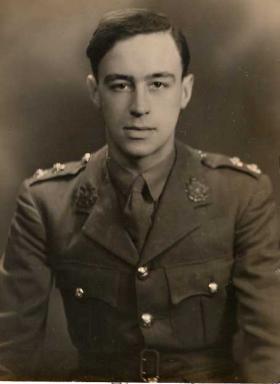Alan Green was born in October 1921 in Leicestershire. He joined the Army and was commissioned into the Border Regiment in 1942.
In October 1942, he was posted to the 1st Battalion, which had become a gliderborne unit as part of the 1st Airlanding Brigade. During the airborne invasion of Sicily in July 1943, he was OC of 15 Platoon, C Company. The glider he was one of the many that landed in the sea when the gliders were cast off by their tugs too early. After a night clinging to the wreckage, Alan and Private O’Hanlon swam ashore and managed to raise a rescue mission for their comrades. Undaunted by this experience he remained with the Borders and saw service on the Italian mainland (Op Slapstick) before returning to the UK at the end of 1943.
By September 1944, Alan was a Lieutenant commanding 20 Platoon, D Company. The Border Regiment was one of the infantry units initially tasked with acting as a guard force for the landing and dropping zones. Once this was completed they moved to their pre-allocated position in the 1st Airborne Division’s theoretical perimeter around Arnhem. The Borders were instructed to act as the western-facing defensive screen around the village of Oosterbeek, some 4 miles from the Arnhem Road Bridge. D Company was positioned astride a road called the van Borsselenweg, and in particular around a large farmhouse towards the southern end of this road (the farmhouse is still there today).
Alan Green and the rest of D Company stoutly defended this area until the very end of the fighting, giving little ground to the Germans. Lt Green was wounded five times during this period. Due to their isolated position, communication was difficult and after being out of touch with Battalion HQ for about two days, Corporal Fisher was sent on a solo recce patrol to see if he could find them. After a precarious trip, he reached HQ and returned with news of the impending evacuation across the Rhine. Consequently, D Coy were instructed to withdraw immediately nearer the Divisional perimeter. As he arrived in the corner of the Company position the area came under a heavy German bombardment. Cpl Fisher was under the impression, that they had been overrun. Calling out to the men closest to him to accompany him, they withdrew.
D Company was relatively intact, but there was much concern for the many seriously wounded who it had been impossible to get to one of the aid posts. There had been a discussion between the senior commanders who were still alive. Few are believed to have been unwounded and it was felt that an attempt should be made to negotiate a temporary truce to evacuate their casualties. Alan was the man selected to go forward and whilst doing so walked into a German mortar barrage which caused an additional four wounds. His attempt ended in failure and the men of D Company held on for as long as possible, but were unaware of the withdrawal of the rest of the Division across the river.
Alan Green was eventually taken prisoner, along with many of the remaining men from D Coy, and ended up at Oflag IX A/X at Rotenburg an der Fulda. In March 1945, Alan and the majority of his comrades trudged eastwards across Germany by their captors as they retreated from the American advance. He was eventually liberated and rejoined the Battalion in 1945 and served in Norway and Germany before leaving Airborne service. His final post before leaving the Army was as Staff Captain Q with a Static Element HQ.
Leaving the Regular Army, he became a teacher for 15 years, before training to be a priest, and was ordained in 1964. As a Captain in the Royal Leicestershire Regiment (TA) he served on the TA Brigade Staff. On becoming a priest he transferred to the Royal Army Chaplain’s Department.
In 1989 he published a book called ’1st Battalion The Border Regiment Arnhem’, which was expanded with the help of Stuart Eastwood and Mike Gray into the classic Arnhem book called ’When Dragons Flew: The History of the 1st Battalion The Border Regiment 1939-45' (1994). A biography, A fragment of a life was published by his son.
Alan died in December 2004 after a battle with cancer.
With assistance from Peter Green and Niall Cherry.
Read More


Latest Comments
There are currently no comments for this content.
Add Comment
In order to add comments you must be registered with ParaData.
If you are currently a ParaData member please login.
If you are not currently a ParaData member but wish to get involved please register.